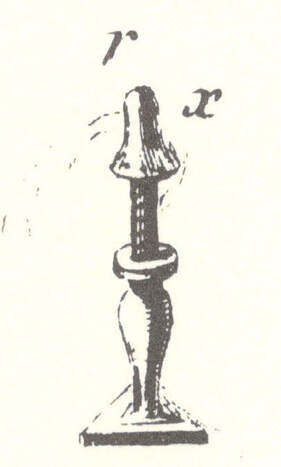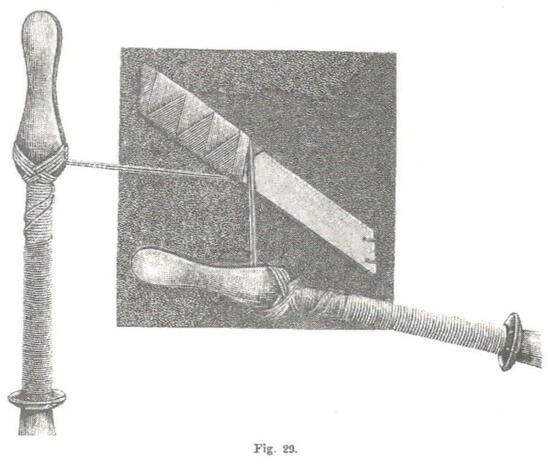|
Last week's blog sparked a very interesting discussion on the use of the broche in goldwork embroidery. And since two more historical books on goldwork embroidery have arrived since, I thought I'll share the additional information in another blog post.
Monica Dutting from the Netherlands reminded me that goldwork embroidery is very popular in the Arab world as well. When we started to look at pictures and videos of the stitching of the Kiswa (the goldwork embroidered covering of the Kaaba in Mecca) we saw that the embroiderers use a wooden broche as well. You can see their broche in action in the above video together with some pretty spectacular goldwork embroidery. Unless you are fluent in Arabic, you probably want to forward the video to 19:25.
If you look closely, you see that their broche is a rather simple piece of rectangular wood on which the gold- and silver threads are wrapped. At one end, the Arab broche has a groove. The metal thread is secured to this groove with a piece of white string or yarn and then wrapped onto the shaft. By the way, the metal threads used on the Kiswa are apparently produced in Germany. Now that's probably Austria, in Vienna, to be more precise :). Annelies Englram from Germany commented on last week's blog post that she had been advised by an elderly master embroiderer from Germany that you do need to wrap the broche with perle in order to protect the goldthread. By now, I am pretty sure that this advice can be tracked down to Ms Dillmont's needlework encyclopedia. No other historical source (not associated with Ms Dillmont) I have been able to track down uses any kind of 'protection' with the broche. The simple piece of wood used in the video on the Kiswa is a stark reminder of this as well. Instead, I believe, as Ms Dillmont wrote her book to promote the use of DMC needlework products, that the use of the perle must be seen in that light. After all, DMC never sold 'real' goldthreads. In order to be able to include a chapter on goldwork embroidery in her book, she needed to make sure that she promoted DMC products as much as she could. And the advice Annelies was given shows that it worked. In one respect, however, the advice Ms Dillmont gives, resembles that seen in the Kiswa video above: "The body and the lower part of the prongs are first covered with a double thread of DMC pearl cotton (Coton perle), yellow or grey, ending with a loop, to which the gold or silver thread to be wound on to the spindle is attached. The thread is usually wound double on to the spindle" (Dillmont 1945, 186-187). The embroiderers of the Kiswa also use a loop of thread to secure their metal threads in the groove of their broche. With the type of broche depicted in Ms Dillmont's needlework encyclopedia, this is, however, unnecessary as the metal thread itself can be looped and placed in the groove/prongs.
One of the new historical books that arrived last week was 'The Art of the Embroiderer' by Charles Germain de Saint-Aubin, originally published in 1770. And originally published in French, but luckily translated in English. De Saint-Aubin was embroiderer at the court of the French kings and he wrote down everything he knew about embroidery. And this is what he wrote about the broche: "A boxwood tool about six inches long with a triangular base to keep it from rolling around as it is used. One winds the gold or chenille for couching on the hollowed-out section of the spindle. One passes the end of the thread through the cut in its head while working so that one touches only the spindle and never the gold for fear of tarnishing it. One draws out the thread from the top end or the cut, as one uses it. After it is unwound several turns, it is then replaced in the cut which holds and keeps it firm while being used" (Saint-Aubin 1770/1983, 65).
Now, this is an interesting one: putting the thread end(s) through the groove at the top for more control. In the above video, I experiment with using the broche this way. It does work, but it comes at the disadvantage of touching the gold more, than when you don't use the broche this way. And after seeing the male embroiderers working with their broche in the Kiswa factory in Mecca, I don't think this has been the common way in which the medieval broche was used.
This is what De Saint-Aubin's broche looks like. And thanks to Jane Drummond from the UK for sending a clearer picture of the coat of arms of the Broderers Guild of London, this is the exact type of broche depicted in that coat of arms.
And last but not least, I managed to find another charming historical source: 'Die Kunst der Goldstickerei' by Amelie von Saint-George published in 1902. She was a tutor at the Kaiserlich-Königliche Fachschule für Kunststickerei in Vienna. Very well possible that this is the same embroidery school Ms Dillmont had been instructed at. Here we read: "... so spult man das Gold - gewöhnlich einen doppelt genommenen Faden - auf die Bretsche, das zum Sprengen nötige Werkzeug. Zur Schonung des Goldes wird sie vorher mit starken Seidenfäden dicht umwickelt" (Saint-George 1902, 13). This translates as: wrap the gold - usually taken double - onto the broche, which is a mandatory tool for couching. To protect the gold, wrap the broche with thick silk yarn first. Above you see a picture from this book with two broche in action. Interestingly, here we have the wrapping again and the threads spool from the groove. What could be behind this?
Remember, this book was published nearly a decade after Ms Dillmont's needlework encyclopedia. Ms Dillmont and Ms von Saint-George probably knew each other personally as they likely went to the same school. Ms Dillmont wraps with perle as this is a cheap and readily available DMC thread. Ms von Saint-George recommends silk as she writes in her introduction at length about the fact that goldembroidery is for the happy few (she tutored at the Imperial School of Needlework!). Silk is a far more expensive thread than perle. Ms von Saint-George clearly knew Ms Dillmont's needlework encyclopedia. She knew the wrapping advice. So when she wrote her book, she had drawings made that look rather similar to those in the needlework encyclopedia, but a little bit more realistic, I feel. I might be wrong, but as no other historical or contemporary source recommends the wrapping of the broche, this seems a logical deduction to me. Personally, I would not wrap my broche. Anyone working with passing threads will know that they have a tendency to snag on any type of yarn. Imagine wrapping your perfectly smooth broche with yarn and then wrap your snag-happy passing thread onto it ... Please feel free to leave a comment below. I'll keep looking for more advice on using a broche. And maybe I can start a collection of different broche from all over the world past and present:). Literature Dillmont, Th. de (1945). Encyclopedia of Needlework, revised edition. Mulhouse: Th. de Dillmont. Saint-Aubin, C. G. de (1770/1983). The art of the embroiderer. Translated and annotated by Nikki Scheuer. Los Angeles: Country Museum of Art. Saint-George, A. von (1902). Die Kunst der Goldstickerei nebst einer Anleitung zur Verwendung der Goldstickerei in Verbindung mit Applikation. Wien: Wiener Mode.
0 Comments
Your comment will be posted after it is approved.
Leave a Reply. |
Want to keep up with my embroidery adventures? Sign up for my weekly Newsletter to get notified of new blogs, courses and workshops!
Liked my blog? Please consider making a donation or becoming a Patron so that I can keep up the good work and my blog ad-free!
Categories
All
Archives
July 2024
|
Contact: info(at)jessicagrimm.com
Copyright Dr Jessica M. Grimm - Mandlweg 3, 82488 Ettal, Deutschland - +49(0)8822 2782219 (Monday, Tuesday, Friday & Saturday 9.00-17.00 CET)
Impressum - Legal Notice - Datenschutzerklärung - Privacy Policy - Webshop ABG - Widerrufsrecht - Disclaimer
Copyright Dr Jessica M. Grimm - Mandlweg 3, 82488 Ettal, Deutschland - +49(0)8822 2782219 (Monday, Tuesday, Friday & Saturday 9.00-17.00 CET)
Impressum - Legal Notice - Datenschutzerklärung - Privacy Policy - Webshop ABG - Widerrufsrecht - Disclaimer








 RSS Feed
RSS Feed